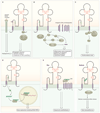CD36, a scavenger receptor involved in immunity, metabolism, angiogenesis, and behavior
- PMID: 19471024
- PMCID: PMC2811062
- DOI: 10.1126/scisignal.272re3
CD36, a scavenger receptor involved in immunity, metabolism, angiogenesis, and behavior
Abstract
CD36 is a membrane glycoprotein present on platelets, mononuclear phagocytes, adipocytes, hepatocytes, myocytes, and some epithelia. On microvascular endothelial cells, CD36 is a receptor for thrombospondin-1 and related proteins and functions as a negative regulator of angiogenesis. On phagocytes, through its functions as a scavenger receptor recognizing specific oxidized phospholipids and lipoproteins, CD36 participates in internalization of apoptotic cells, certain bacterial and fungal pathogens, and modified low-density lipoproteins, thus contributing to inflammatory responses and atherothrombotic diseases. CD36 also binds long-chain fatty acids and facilitates their transport into cells, thus participating in muscle lipid utilization, adipose energy storage, and gut fat absorption and possibly contributing to the pathogenesis of metabolic disorders, such as diabetes and obesity. On sensory cells, CD36 is involved in insect pheromone signaling and rodent fatty food preference. The signaling pathways downstream of CD36 involve ligand-dependent recruitment and activation of nonreceptor tyrosine kinases, specific mitogen-activated protein kinases, and the Vav family of guanine nucleotide exchange factors; modulation of focal adhesion constituents; and generation of intracellular reactive oxygen species. CD36 in many cells is localized in specialized cholesterol-rich membrane microdomains and may also interact with other membrane receptors, such as tetraspanins and integrins. Identification of the precise CD36 signaling pathways in specific cells elicited in response to specific ligands may yield novel targets for drug development.
Figures


References
-
- Clemetson KJ, Pfueller ST, Luscher EF, Jenkins CSP. Isolation of the membrane lycoproteins of human blood platelets by lection affinity chromatography. Biochim. Biophys. Acta. 1977;464:493–508. - PubMed
-
- Knowles DM, Tolidijian B, Marboe C, Agati VD, Grimes M, Chess L. Monoclonal anti-human monocyte antibodies OKM1 and OKM5 possess distinctive tissue distributions including differential reactivity with vascular endothelium. J. Immunol. 1984;132:2170–2173. - PubMed
-
- Oquendo P, Hundt E, Lawler J, Seed B. CD36 directly mediates cytoadherence of Plasmodium falciparum parasitized erythrocytes. Cell. 1989;58:95–101. - PubMed
-
- Calvo D, Dopazo J, Vega MA. The CD36, CLA-1 (CD36L1), and LIMPII (CD36L2) gene family: Cellular distribution, chromosomal location, and genetic evolution. Genomics. 1995;25:100–106. - PubMed
Publication types
MeSH terms
Substances
Grants and funding
LinkOut - more resources
Full Text Sources
Other Literature Sources
Molecular Biology Databases
Miscellaneous

